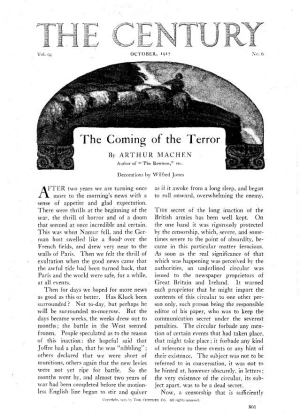Birthday Reviews: Arthur Machen’s “The Coming of the Terror”

Arthur Machen was born Arthur Llewellyn Jones on March 3, 1863 and died on December 15, 1947.
Machen had a strong interest in the occult and published his first poem, “Eleusinia” when he was 18 years old. He struggled as a writer before seeing more success in the 1890s, including the publications of his story “The Great God Pan” in 1894. In the early days of World War I he published the short story “The Bowman” which described phantom bowman from Agincourt called upon to help the British Expeditionary Force at the Battle of Mons. The story entered into popular culture as an actual description of the battle and led to the folklore around the “Angels of Mons.”
Machen originally published “The Coming of the Terror” in The Century, an illustrated magazine published from 1881 to 1930, although it grew out of Scribner’s Monthly, which dated back to 1870. The story was part of his longer novel The Terror and has rarely been reprinted only its own, only seeing print in 2003 in the Chaosium collection of Machen’s story’s The White People and Other Stories and that same year in Douglas Anderson’s anthology Tales Before Tolkien: The Roots of Modern Fantasy.
“The Coming of the Terror” feels a lot like one of the stories H.P. Lovecraft would begin publishing five years later, but with significant differences. Machen’s tale of mysterious deaths during the Great War slowly builds from reporting on the crash of an airman who hit a swarm of pigeons to the seemingly unrelated deaths and disappearances in a small village in Wales. The deaths lead to paranoia that the Germans have somehow managed to attack the English countryside undetected, either using a strange new weapon or by infiltrating the citizenry.
While Lovecraft cites Machen as one of his sources (and Machen mentions the original village of Dunwich in this story), “The Coming of the Terror” really isn’t Lovecraftian in nature. Machen doesn’t use excessively purple prose to describe the sinister events occurring around his Welsh village of Porth. Furthermore rather than being witnessed by a single individual, the effects are widespread. Everyone is aware that something is happening, and the fact that the newspapers refuse to report on it just make the conjectures that much more horrific. Machen allows events to build slowly, from a single incident to several, their relationship to each other only explicit because they are all taking place in the same story.
The story ultimately falls apart when Machen tries to explain what is happening. Two of his characters, the narrator and Dr. Lewis, propose separate theories, neither of which is particularly plausible or convincing. Earlier in the tale Mr. Remnant offered his own conspiratorial theories that tie into the Great War, which are just as convincing.
Reviewed in its original publication in the magazine The Century, October, 1917.
 Steven H Silver is a fifteen-time Hugo Award nominee and was the publisher of the Hugo-nominated fanzine Argentus as well as the editor and publisher of ISFiC Press for 8 years. He has also edited books for DAW and NESFA Press. He began publishing short fiction in 2008 and his most recently published story is “Big White Men—Attack!” in Little Green Men—Attack! Steven has chaired the first Midwest Construction, Windycon three times, and the SFWA Nebula Conference 5 times, as well as serving as the Event Coordinator for SFWA. He was programming chair for Chicon 2000 and Vice Chair of Chicon 7. He has been the news editor for SF Site since 2002.
Steven H Silver is a fifteen-time Hugo Award nominee and was the publisher of the Hugo-nominated fanzine Argentus as well as the editor and publisher of ISFiC Press for 8 years. He has also edited books for DAW and NESFA Press. He began publishing short fiction in 2008 and his most recently published story is “Big White Men—Attack!” in Little Green Men—Attack! Steven has chaired the first Midwest Construction, Windycon three times, and the SFWA Nebula Conference 5 times, as well as serving as the Event Coordinator for SFWA. He was programming chair for Chicon 2000 and Vice Chair of Chicon 7. He has been the news editor for SF Site since 2002.